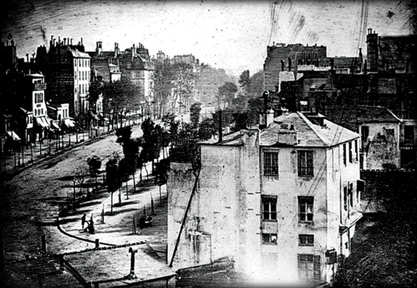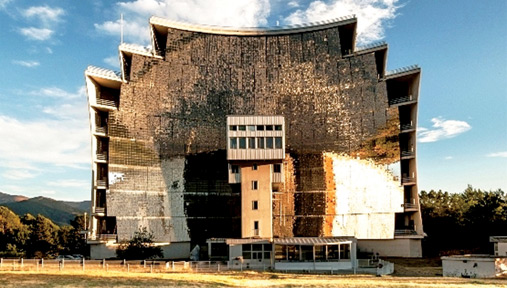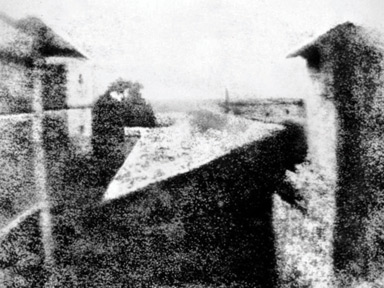|
World Photography Day on Tuesday:
Celebrating 175 years of pictures
By Husna INAYATHULLAH
|

“Boulevard du Temple”, a daguerreotype made by Louis
Daguerre in 1838, is generally accepted as the earliest
photograph of people. It is a view of a busy street, but
because the exposure time was at least ten minutes, the
moving traffic left no trace. Only the two men near the
bottom left corner, one apparently having his boots polished
by the other, stayed in one place long enough to be visible. |
“A picture is worth a thousand words” is an old adage which refers to
the notion that a complex idea can be conveyed with just a single still
image. It also aptly characterises one of the main goals of
visualisation, namely making it possible to absorb large amounts of data
quickly.
Photography is the art, science and practice of creating durable
images by recording light or other electromagnetic radiation, either
chemically by means of a light-sensitive material such as photographic
film, or electronically by means of an image sensor.
Typically, a lens is used to focus the light reflected or emitted
from objects into a real image on the light-sensitive surface inside a
camera during a timed exposure. The result in an electronic image sensor
is an electrical charge at each pixel, which is electronically processed
and stored in a digital image file for subsequent display or processing.
The result in a photographic emulsion is an invisible latent image,
which is later chemically developed into a visible image, either
negative or positive depending on the purpose of the photographic
material and the method of processing. A negative image on film is
traditionally used to photographically create a positive image on a
paper base, known as a print, either by using an enlarger or by contact
printing.
Visual
World Photo Day is about celebrating the ability we have to
communicate through this powerful visual medium.
Today, we can share memories across the globe in seconds. Photography
is an invention that has revolutionised the way we see the world. We can
visit places without leaving home. We can share adventures with friends
in another city and we can watch grandchildren grow up thousands of
kilometres away.
|

Tarassaco by Francesca Donadini |
World Photo Day 2014, celebrated on August 19 marks a special
anniversary for photographers across the globe. It marks the 175th
anniversary of the first permanent photographic process patented and
freely released to the world on August 19th, 1839.
This year, World Photo Day is encouraging businesses, organisations
and social groups across the world to leverage the power of photography
by engaging their communities as part of a global photography
celebration held over August.
“So often, we forget that there was once a time that we couldn’t
instantly share moments with friends and family across the globe”, said
Korske Ara, founder of World Photo Day. “Today, we take photography for
granted.”
Popular
The first commercially available 35mm film camera was developed only
90 years ago. The digital camera became popular just 20 years ago and 15
years ago, camera phones didn’t exist. Today, everyone is impacted by
the influence of photography.
Invented in the early decades of the 19th century, photography by
means of the camera seemed able to capture more detail and information
than traditional media, such as painting and sculpture. Photography
dates to the 1820s with the discovery of chemical photography. The first
permanent photoetching was an image produced in 1822 by the French
inventor Nicéphore Niépce, but it was destroyed in a later attempt to
make prints from it.
Niépce was successful again in 1825. He made the View from the Window
at Le Gras’ the earliest surviving photograph from nature (i.e., of the
image of a real-world scene, as formed in a camera obscura by a lens),
in 1826 or 1827.
|

130801-572237 by Alastair Philip Wiper |
Niépce died in 1833 and Daguerre then redirected the experiments
toward the light-sensitive silver halides, which Niépce had abandoned
many years earlier because of his inability to make the images he
captured with them light-fast and permanent. Daguerre’s efforts
culminated in what would later be named the daguerreotype process, the
essential elements of which were in place in 1837.
Earliest
The Daguerreotype wasn’t the first permanent photographic image. In
1826, Nicèphore Nièpce captured the earliest known permanent photograph
known as ‘View from the Window at Le Gras’ using a process called
Heliography.
August 19th, 1839 was chosen as the date behind World Photo Day based
on the following historical merits:
*The Daguerreotype was the first practical photographic process.
*The purchase and release of the patent by the French government.
In 2009, Korske Ara, a passionate young photographer from Australia
launched the World Photo Day Project with the dream to unite local and
global communities in a worldwide celebration of photography.
On August 19, 2010, World Photo Day hosted it’s first global online
gallery. With 270 photographs shared and website visitors from over 100
countries, this marked the first official, globally reaching World Photo
Day.
Since the launch of the project, we’ve heard from people that have
been celebrating photography on August 19 in their local communities
prior to 2010. There’s also evidence of an attempt to start a June 1
photography celebration in 2005.
|

In 1826, French scientist Joseph Nicéphore Niépce, took that
photograph, titled View from the Window at Le Gras’ at his
family’s country home. Niépce produced his photo - a view of
a courtyard and outbuildings seen from the house’s upstairs
window - by exposing a bitumen-coated plate in a camera
obscura for several hours on his windowsill. |
“I believe that photography has the power to tell stories, inspire
generations and initiate change in the world,” says Korske Ara, Founder
of World Photo Day.
Celebration
Founded in 2009, World Photo Day hosted its first global, online
gallery in 2010 with the goal to unite local and global communities in a
worldwide celebration of photography. Since its initial launch, The
World Photo Day project has grown from an idea into a global event as
photographers around the globe have joined the celebration.
Whether you own a Compact, Digital SLR, Film or Phone Camera, World
Photography Day is all about celebrating photography. World Photography
Day is an open community event focused on celebrating photography not
just globally but within local communities.
The annual awards gala and ceremony takes place in London, welcoming
an international attendance of industry leaders to celebrate the
recognition of the best in contemporary photography and each year also
pays tribute to one of our masters with the Outstanding Contribution to
Photography Award. |

